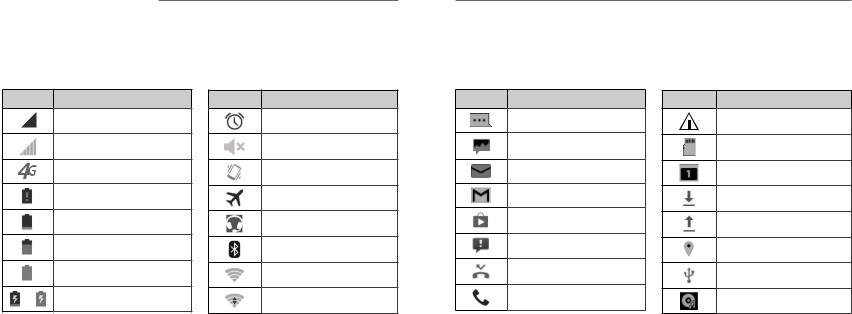ZTE Paragon, Z743G User Manual

USER MANUAL
Z8090171100MT
www.zteusa.com |
Z753G |
|
|

About This Manual
Thank you for choosing this ZTE mobile device. In order to keep your device in its best condition, please read this manual and keep it for future reference.
Copyright © 2015 ZTE CORPORATION All rights reserved.
No part of this publication may be quoted, reproduced, translated or used in any form or by any means, electronic or mechanical, including photocopying and microfilm, without the prior written permission of ZTE Corporation.
Notice
ZTE Corporation reserves the right to make modifications on print errors or update specifications in this manual without prior notice. This manual has been designed with the utmost care to ensure the accuracy of its content. However, all statements, information and recommendations contained therein do not constitute a warranty of any kind, either expressed or implied. Please refer to chapter For Your Safety to be sure to use your phone properly and safely.
We offer self-service for our smart terminal device users. Please visit the ZTE official website (at www.ztedevice.com) for more information on self-service and supported product models. Information on the website takes precedence.
Disclaimer
ZTE Corporation expressly disclaims any liability for faults and damages caused by unauthorized modifications of the software.
Images and screenshots used in this manual may differ from the actual product. Content in this manual may differ from the actual product or software.
Trademarks
ZTE and the ZTE logos are trademarks of ZTE Corporation. Google and Android are trademarks of Google, Inc.
The Bluetooth® trademark and logos are owned by the Bluetooth SIG, Inc. and any use of such trademarks by ZTE Corporation is under license.
The microSDHC logo is a trademark of SD-3C, LLC.
Qualcomm® Snapdragon™ processors are products of Qualcomm Technologies, Inc. Qualcomm and Snapdragon are trademarks of Qualcomm Incorporated, registered in the United States and other countries. Used with permission.
Other trademarks and trade names are the property of their respective owners.
Edition Time: January 2015 Manual No.: Z8090171100MT
Table of Contents |
|
Getting Started................................................. |
5 |
Installing the Battery and microSDHC™ Card........ |
5 |
Charging the Battery............................................. |
5 |
Extending the Battery Life..................................... |
6 |
Powering Your Phone On/Off................................. |
6 |
Setting Up Your Phone for the First Time................ |
6 |
Locking/Unlocking the Screen and Keys................. |
6 |
Using the Touch Screen......................................... |
7 |
Getting to Know Your Phone................................. |
8 |
Getting to Know the Home Screen...................... |
10 |
Personalizing................................................... |
11 |
Changing the System Language.......................... |
11 |
Setting the Date and Time................................... |
11 |
Changing the Ringtone and Notification Sound... |
11 |
Turning Touch Sounds On/Off.............................. |
11 |
Adjusting Volumes.............................................. |
11 |
Switching to Silent Mode.................................... |
11 |
Applying New Wallpapers................................... |
12 |
Changing the Screen Brightness.......................... |
12 |
Protecting Your Phone With Screen Locks............ |
12 |
Protecting Your Phone With Encryption................ |
13 |
Knowing the Basics........................................ |
14 |
Monitoring the Phone Status............................... |
14 |
Managing Notifications....................................... |
15 |
Managing Apps and Widgets............................... |
17 |
Organizing With Folders...................................... |
17 |
Rearranging the Favorites Tray............................. |
17 |
Entering Text....................................................... |
18 |
Editing Text......................................................... |
19 |
Opening and Switching Apps............................... |
20 |
Connecting to Networks and Devices.......... |
21 |
Connecting to Mobile Networks.......................... |
21 |
Connecting to Wi-Fi®.......................................... |
21 |
Connecting to Bluetooth® Devices....................... |
23 |
Connecting to Your Computer via USB................. |
24 |
Connecting to Virtual Private Networks............... |
25 |
Phone Calls...................................................... |
27 |
Placing and Ending Calls..................................... |
27 |
Answering or Rejecting Calls............................... |
27 |
Working With the Call Log.................................. |
27 |
Calling Your Contacts.......................................... |
28 |
Checking Voicemail............................................. |
28 |
Using Options During a Call................................ |
28 |
Managing Multi-party Calls................................. |
29 |
Adjusting Your Call Settings................................ |
30 |
People.............................................................. |
31 |
Checking Contact Details.................................... |
31 |
Adding a New Contact........................................ |
31 |
Setting Up Your Own Profile................................ |
31 |
Importing, Exporting, and Sharing Contacts......... |
31 |
Working With Favorite Contacts.......................... |
32 |
Working With Groups.......................................... |
32 |
Searching for a Contact....................................... |
33 |
Editing Contacts................................................. |
33 |
|
1 |

Table of Contents
Accounts.......................................................... |
34 |
Adding or Removing Accounts............................. |
34 |
Configuring Account Sync................................... |
34 |
Email................................................................. |
35 |
Setting Up the First Email Account....................... |
35 |
Checking Your Emails.......................................... |
35 |
Responding to an Email...................................... |
35 |
Writing and Sending an Email............................. |
36 |
Adding a Signature to Your Emails....................... |
36 |
Adding and Editing Email Accounts..................... |
36 |
Changing General Email Settings......................... |
37 |
Gmail™............................................................ |
38 |
Opening Your Gmail Inbox................................... |
38 |
Switching Accounts............................................. |
38 |
Writing and Sending a Message.......................... |
38 |
Adding a Signature to Your Gmail Messages........ |
38 |
Replying to or Forwarding a Message.................. |
38 |
Working With Received Attachments................... |
39 |
Working With Labels........................................... |
39 |
Changing Gmail Settings..................................... |
40 |
Messaging....................................................... |
41 |
Opening the Messaging Screen........................... |
41 |
Sending a Text Message...................................... |
41 |
Replying to a Message........................................ |
41 |
Forwarding a Message........................................ |
41 |
Deleting Messages or Threads............................. |
42 |
Changing Message Settings................................ |
42 |
Calendar........................................................... |
43 |
Viewing Your Calendars and Events..................... |
43 |
Creating an Event............................................... |
43 |
Editing or Deleting an Event................................ |
44 |
Changing Calendar Settings................................ |
44 |
Google+™....................................................... |
45 |
Getting Started With Google+............................. |
45 |
Changing Google+ Settings................................ |
45 |
Browser............................................................ |
46 |
Opening the Browser.......................................... |
46 |
Working With an Opened Page............................ |
46 |
Using Multiple Browser Tabs............................... |
47 |
Downloading Files.............................................. |
47 |
Using Bookmarks................................................ |
47 |
Viewing Your Browsing History............................ |
48 |
Changing Browser Settings................................. |
48 |
Google Maps™............................................... |
49 |
Activating Location Services................................ |
49 |
Getting Your Location......................................... |
49 |
Searching for a Location...................................... |
49 |
Getting Directions to Your Destination................. |
49 |
Searching for Local Places................................... |
50 |
Google Now™ and Search............................ |
51 |
Enabling Google Now......................................... |
51 |
Searching With Text............................................. |
51 |
Searching by Speaking........................................ |
51 |
Changing Search and Voice Search Settings......... |
51 |
Table of Contents
Camera............................................................. |
52 |
Capturing a Photo.............................................. |
52 |
Using Manual Camera Mode............................... |
52 |
Recording a Video............................................... |
52 |
Customize Camera Settings................................. |
53 |
Gallery.............................................................. |
54 |
Opening the Gallery............................................ |
54 |
Working With Albums......................................... |
54 |
Working With Pictures......................................... |
54 |
Playing Videos.................................................... |
55 |
Music................................................................ |
56 |
Copying Music Files to Your Phone...................... |
56 |
Viewing Your Music Library.................................. |
56 |
Playing Music..................................................... |
57 |
Managing Playlists.............................................. |
57 |
Play Music........................................................ |
58 |
Playing Your Music.............................................. |
58 |
Managing Playlists.............................................. |
59 |
Video Player.................................................... |
60 |
Opening the Video Library................................... |
60 |
Playing and Controlling Videos............................ |
60 |
Managing Video Files.......................................... |
60 |
Sound Recorder............................................... |
61 |
Recording a Voice Memo..................................... |
61 |
Playing a Voice Memo......................................... |
61 |
More Apps....................................................... |
62 |
Clock ................................................................. |
62 |
Calculator........................................................... |
62 |
Chrome™.......................................................... |
62 |
Downloads......................................................... |
62 |
File Manager...................................................... |
63 |
Note ................................................................. |
63 |
Play Books.......................................................... |
63 |
Play Movies & TV................................................ |
63 |
Task Manager..................................................... |
63 |
YouTube™......................................................... |
63 |
Play Store......................................................... |
64 |
Browsing and Searching Apps............................. |
64 |
Downloading and Installing Apps........................ |
64 |
Creating a Google Wallet™ Account................... |
64 |
Requesting a Refund for a Paid App.................... |
64 |
Managing Your Downloads................................. |
65 |
Settings............................................................ |
66 |
General Settings................................................. |
66 |
Wireless and Networks....................................... |
67 |
Device................................................................ |
68 |
Personal............................................................. |
68 |
Accounts............................................................ |
69 |
System................................................................ |
69 |
Upgrading the Phone Software.................... |
70 |
Troubleshooting.............................................. |
71 |
2 |
3 |

Table of Contents |
|
For Your Safety................................................ |
74 |
General Safety.................................................... |
74 |
Radio Frequency (RF) Energy............................... |
75 |
FCC Compliance................................................. |
75 |
Hearing Aid Compatibility (HAC) Regulations for |
|
Mobile Phones.................................................... |
76 |
Distraction.......................................................... |
77 |
Product Handling................................................ |
77 |
Electrical Safety................................................... |
79 |
Radio Frequency Interference.............................. |
80 |
Explosive Environments....................................... |
81 |
Specifications.................................................. |
82 |
Notes................................................................ |
83 |
4
Getting Started
Installing the Battery and a microSDHC Card
Power off your phone before installing or replacing the battery. You have the option to install a microSDHC card of up to 32 GB to expand your phone’s storage capacity. The microSDHC card can be installed and removed while the phone is turned on. Unmount the microSDHC card before removing it.
1.Place your finger in the slot at the bottom of the back cover to lift and remove the cover.
2.Insert the battery by aligning the contacts on the battery with the gold contacts in the battery
compartment. Gently push down on the battery until it clicks into place.
WARNING! Do not handle a damaged or leaking Li-Ion battery as you can be burned.
3.Hold your microSDHC card with the metal contacts facing down and slide it into the microSDHC card slot until you hear a click.
4.Press the cover gently back into place until you hear a click.
Charging the Battery
When you first get your new phone you’ll need to charge the battery. If the battery is low, there will be a pop-up message on the screen. As you charge your phone, the screen will tell you the exact battery level each time you wake up your phone.
WARNING! Use only ZTE-approved chargers and cables. The use of unapproved accessories could damage your phone or cause the battery to explode.
1.Connect the adapter to the charging port. Ensure that the adapter is inserted with the correct orientation. Do not force the connector into the charging port.
5

Getting Started
2.Connect the charger to a standard AC wall outlet. If
the phone is on, you’ll see a charging icon, such as
 or
or  , appear in the Status Bar.
, appear in the Status Bar.
3.Disconnect the charger when the battery is fully charged.
NOTE: If the battery is extremely low, you may be unable to power on the phone even when it is being charged. In this case, try again after charging the phone for at least 10 minutes. Contact customer service if
you still cannot power on the phone after prolonged charging.
Extending the Battery Life
Active applications, screen brightness levels, Bluetooth and Wi-Fi usage, and GPS functionality can drain
your battery. You can follow the helpful tips below to conserve your battery power:
•Reduce the screen backlight time.
•Lower the screen brightness.
•Turn auto-sync,Wi-Fi, and Bluetooth off when not in use.
•Disable the GPS function when not in use. Most applications using this function will periodically query the GPS satellites for your current location; each query drains your battery.
•To turn it off, press and hold the Power/Lock Key to open the options menu. Tap Power off and then tap OK.
Setting Up Your Phone for the First Time
When you first power on your phone after you purchase it or reset it to factory settings (see Settings – Personal
– Backup & Reset), you may need to set it up before using it.
1.Tap the language field, select the language you want, and tap Start.
2.Connect to a Wi-Fi network and tap Next. Otherwise, tap Skip.
3.Set the date, time, and time zone, or use date and time data provided by the network. Then tap Next.
4.If you have a Google™ account, tap Existing to sign in. Tap New to create a Google account or tap Not now to set up an account later.
5.Configure the Google location options and tap Next.
6.Enter your name, which the phone uses to personalize some apps, and then tap  .
.
7.You will be prompted to accept the Google terms of service. Tap Next to continue.
8.Tap Finish to complete the setup.
Powering Your Phone On/Off
•Press and hold the Power/Lock Key to turn on your phone.
6
Locking/Unlocking the Screen and Keys
Your phone allows you to quickly lock the screen and keys (put the phone into Sleep mode) when not in use,
Getting Started
and also to turn the screen back on and unlock it when you need it.
To lock the screen and keys:
To quickly turn the screen off and lock the keys, press the Power/Lock Key.
NOTE: To save battery power, the phone automatically turns off the screen after a certain period of time
when you leave it idle. You will still be able to receive messages and calls while the phone screen is off.
To unlock the screen and keys:
1.Press the Power/Lock Key to turn the screen on.
2.Press and hold a blank area of the screen.
NOTE: If you have set an unlock pattern, PIN, or password for your phone (see Personalizing –
Protecting Your Phone With Screen Locks), you’ll need to draw the pattern or enter the PIN/password to unlock your screen.
•Swipe or Slide – To swipe or slide means to quickly drag your finger vertically or horizontally across the screen.
•Drag – To drag, press and hold your finger with some pressure before you start to move your finger. While dragging, do not release your finger until you have reached the target position.
•Pinch – In some apps (such as Maps, Browser, and Gallery), you can zoom in and out by placing two fingers on the screen at once and pinching them together (to zoom out) or spreading them apart (to zoom in).
•Rotate the screen – For most screens, you can automatically change the screen orientation from portrait to landscape by turning the phone sideways.
Using the Touch Screen
Your phone’s touch screen lets you control actions through a variety of touch gestures.
•Tap – When you want to type using the on-screen keyboard, select on-screen items (such as application and settings icons), or press on-screen buttons, simply tap them with your finger.
•Tap and Hold – To open the available options for an item (for example, a message or link in a web page), tap and hold the item.
7

Getting Started |
|
Getting Started |
|
|
|
Getting to Know Your Phone
Proximity
Sensor
3.5mm Headset Jack
Earpiece
Volume
Up/Down Key
Touch
Screen
Micro USB 
Charging Port
Back Key
Key Functions
|
Back |
|
|
|
Microphone |
Key |
Description |
|
|
|
|
|
|
|
|||
Power/Lock |
Camera |
|
|
|
Power/Lock Key |
Press and hold to turn Airplane mode on or off, restart, enable silent mode/vibration mode/ |
||
Key |
|
|
|
|
|
|
|
sound, or to power off. |
Indicator |
|
|
|
|
|
|
|
Press to change your phone to Sleep mode. |
|
|
|
|
|
|
|
||
Light |
|
|
|
|
|
|
|
Press to wake up your phone. |
|
|
|
|
|
|
|
||
|
|
|
|
|
|
|
|
|
Front Camera |
|
|
|
|
|
|
|
|
|
|
|
|
|
|
Home Key |
Press to return to the home screen from any application or screen. |
|
|
|
|
|
|
|
|
||
|
|
|
|
|
|
|
|
Press and hold to access Google Now. |
|
|
|
|
|
|
|
|
|
Flash |
|
|
|
|
|
|
Recent Apps Key |
Press to see recently used applications. |
|
|
|
|
|
|
Back Key |
Press to go to the previous screen. |
|
|
|
|
|
|
|
|
||
|
|
|
|
|
|
|
|
|
|
|
|
|
|
|
|
Volume Up/ |
Press or hold to turn the volume up or down. |
|
|
|
|
|
|
|
Down Key |
|
Battery Cover |
|
|
|
|
|
|
|
|
|
|
|
|
|
|
|
|
|
|
|
|
|
|
|
|
|
|
Recent
Apps Key
Microphone |
Home Key |
Speaker |
8 |
9 |

Getting Started
Getting to Know the Home Screen
The home screen is the starting point for your phone’s applications, functions, and menus. You can customize your home screen by adding application icons, shortcuts, folders, widgets, and more. Your home screen extends beyond the initial screen. Swipe the screen left or right to display additional screens.
Status &
Notifications
Widget
Wallpaper
Shortcuts 
Favorites
Tray
10
Personalizing
Changing the System
Language
1.Press the Home Key > Apps icon > Settings > Language & input > Language.
2.Select the language you need.
Setting the Date and Time
1.Press the Home Key > Apps icon > Settings > Date & time.
2.Uncheck Automatic date & time and Automatic time zone if you want to set the date, time, and time zone by yourself.
3.Set the date, time, time zone, and date/time format.
Changing the Ringtone and Notification Sound
You can customize the default ringtone for incoming calls and the default notification sound quickly.
1.Press the Home Key > Apps icon > Settings > Sound.
2.Tap Phone ringtone or Default notification sound.
3.Scroll through the list and select the ringtone you’d like to use.
4.Tap OK.
NOTE: See People – Editing Contacts – Setting a Ringtone for a Contact for how to assign a special ringtone to an individual contact.
Turning Touch Sounds On/Off
1.Press the Home Key > Apps icon > Settings > Sound.
2.Check or uncheck Touch sounds.
Adjusting Volumes
1.Press the Home Key > Apps icon > Settings > Sound > Volumes.
2.Drag the sliders to adjust the volume for each type of audio.
3.Tap OK to save.
NOTE: You can adjust the media volume when a media application is in use by pressing the Volume Up/Down Key. If no media application is active, press the Volume Up/Down Key to adjust ringtone volume (or the earpiece volume during a call).
Switching to Silent Mode
You can set the phone to silent mode by using one of the following methods:
•Press and hold the Power/Lock Key and then tap
 to enable silent mode, tap
to enable silent mode, tap  to enable silent mode with vibration, or tap
to enable silent mode with vibration, or tap  to disable silent mode.
to disable silent mode.
•Keep pressing the Volume Down Key when no
media application is active. When the  icon appears in the Status Bar, the phone is set to silent
icon appears in the Status Bar, the phone is set to silent
mode with vibration. When the  icon appears in the Status Bar, the phone is in silent mode.
icon appears in the Status Bar, the phone is in silent mode.
11

Personalizing
•Press the Home Key > Apps icon > Settings > Sound > Silent mode, and tap Off, Vibrate, or Mute.
Applying New Wallpapers
You can set the wallpaper for the home screen or lock screen.
1.Tap and hold any blank area of a home screen.
2.Tap Wallpaper.
3.Tap Wallpaper for home screen or Wallpaper for lock screen.
4.Select a wallpaper source from Gallery,
Wallpapers, Photos, or Live, and choose the image or animation you want to use as the wallpaper.
5.For Gallery images, tap OK at the top of the screen. For Live or Wallpapers, tap Set wallpaper. For Photos, tap SET WALLPAPER.
NOTE: Live Wallpapers and Photos are not available for the lock screen.
Changing the Screen
Brightness
1.Press the Home Key > Apps icon > Settings > Display > Brightness.
2.Tap AUTO to make the phone adjust the screen brightness automatically, or drag the slider to adjust the brightness manually.
12
Protecting Your Phone With Screen Locks
You can protect your phone by creating a screen lock. When enabled, you need to long press the blank area of home screen, draw a pattern or enter a numeric PIN or password to unlock the phone’s screen and keys.
1.Press the Home Key > Apps icon > Settings > Security.
2.Tap Screen lock.
3.Tap None, Long press, Pattern, PIN, or Password.
•Tap None to disable screen lock protection.
•Tap Long press to enable screen lock and allow unlocking with a “tap and hold” gesture. You can unlock the screen by tapping and holding a blank area on the lock screen.
•Tap Pattern to create a pattern that you must draw to unlock the screen.
•Tap PIN or Password to set a numeric PIN or a password that you must enter to unlock the screen.
NOTE: Screen lock options are listed in the approximate order of the strength of their security, starting with None and Long press, which provide no security. A pattern provides minimal security, although it can be more convenient than the stronger options.
Personalizing
IMPORTANT: If you forget the pattern you set, try five times and tap Forgot Pattern to sign in to the Google account you have added on the phone and reset the screen lock. You will need an active Internet connection. You can also upgrade the phone software (see Settings – System – About Phone).
Protecting Your Phone With Encryption
You can encrypt all the data on your phone: Google accounts, application data, music and other media, downloaded information, and more. If you do, you must enter a numeric PIN or password each time you power on your phone.
WARNING! Encryption is irreversible. The only way to revert to an unencrypted phone is to perform a factory data reset, which erases all your data.
Encryption provides additional protection in case your phone is stolen, and may be required or recommended in some organizations. Consult your system administrator before turning it on. In many cases the PIN or password you set for encryption is controlled by the system administrator.
Before turning on encryption, prepare as follows:
•Set a lock screen PIN or password.
•Charge the battery.
•Keep the phone connected to the charger.
•Schedule an hour or more for the encryption process.
You must not interrupt it or you will lose some or all of your data.
When you’re ready to turn on encryption:
1.Press the Home Key > Apps icon > Settings > Security > Encrypt phone.
2.Read the information about encryption carefully.
The Encrypt phone button is dimmed if your battery is not charged or your phone is not plugged in. If you change your mind about encrypting your phone, press the Back Key.
WARNING! If you interrupt the encryption process, you will lose data.
3.Tap Encrypt phone.
4.Enter your lock screen PIN or password and tap Next.
5.Tap Encrypt phone again.
The encryption process starts and displays its progress. Encryption can take an hour or more, during which time your phone may restart several times.
When encryption is complete, you’ll be prompted to enter your PIN or password.
Subsequently, you must enter your PIN or password each time you power on your phone to decrypt it.
13

Knowing the Basics
Monitoring the Phone Status
The Status Bar at the top of the home screen provides phone and service status icons on the right side. Below are some of the icons you may see.
Indicators and Icons |
|
|
|
Indicator |
What it means |
Indicator |
What it means |
|
No signal |
|
Alarm set |
|
Signal strength |
|
Ringer off |
|
4G connected |
|
Vibrate mode |
|
Battery empty |
|
Flight mode |
|
Battery low |
|
Wired headset connected |
|
Battery partially drained |
|
Bluetooth on |
|
Battery full |
|
Connected to a Wi-Fi network |
/ |
Battery charging |
|
Wi-Fi in use |
Knowing the Basics
Managing Notifications
The Status Bar at the top of the home screen provides notification icons on the left side. Below are some of the icons you may see.
Indicators and Icons |
|
|
|
Indicator |
What it means |
Indicator |
What it means |
|
New SMS |
|
microSDHC card removed |
|
New MMS |
|
microSDHC card unmounted |
|
New email |
|
Upcoming event |
|
New Gmail message |
|
Downloading data |
|
|
|
|
|
Updates available |
|
Sending data |
|
|
|
|
|
Problem with SMS/MMS delivery |
|
GPS on |
|
|
|
|
|
Missed call |
|
USB connected |
|
|
|
|
|
Call in progress |
|
Song is playing |
|
|
|
|
14 |
15 |

Knowing the Basics
Opening/Closing the Notification Panel
Notifications report the arrival of new messages, calendar events, and alarms, as well as ongoing events. You can open the Notification Panel to view the details of notifications.
•To open the Notification Panel, swipe your finger down from the top of the screen.
•To close the Notification Panel, swipe your finger up from the bottom of the screen or press the Back Key.
NOTE: If you turn off notifications for an app, you may miss its important alerts and updates. The notifications of some apps cannot be turned off.
Use Quick Settings
The Quick Settings in the notification panel make it convenient to view or change the most common settings for your phone.
In the Notification Panel, tap  at the top of the notifications list to get to the quick settings menu.
at the top of the notifications list to get to the quick settings menu.
• OWNER: Tap to add your personal information.
Responding to or Removing a Notification
In the Notification Panel, you can respond to a notification or remove the notifications. The Notification Panel also supports expandable notifications that
let you perform additional actions right from the notification itself.
•To respond to a notification, tap it.
•To remove a notification, swipe it left or right.
•To remove all notifications, tap  in the top right corner.
in the top right corner.
•Tap and hold a notification and then tap App info to identify the application that created it. To turn off notifications from that application if needed, uncheck Show notifications in the App info screen.
•Most apps that send notifications, such as Gmail, have notification settings that you can adjust.
•BRIGHTNESS: Tap to adjust the screen brightness.
•SETTINGS: Tap to go to the settings menu.
•WI-FI: Tap to turn on or off Wi-Fi.
•DATA: Tap to enable or disable data access over the mobile network.
•AUTO ROTATE: Tap to turn on or off the Auto-rotate feature.
•BATTERY: Tap to see the battery information.
•AIRPLANE: Tap to turn on or off the airplane mode.
•BLUETOOTH: Tap to turn on or off Bluetooth.
•LOCATION: Tap to turn on or off the GPS function.
•SOUND: Tap to switch between vibration and sound.
•SYNC: Tap to turn on or off account synchronization.
•FLASHLIGHT: Tap to turn on or off the flashlight.
16
Knowing the Basics
Managing Apps and Widgets
Adding Apps and Widgets
1.Tap and hold an empty place on the home screen, and then tap Widgets or Apps.
2.Tap and hold an item and drag it to a home screen thumbnail at the bottom of the screen.
Moving Apps or Widgets
2.Drag the app to  and release it. A new folder will be created and the app is added to the folder.
and release it. A new folder will be created and the app is added to the folder.
Renaming a Folder
1.Tap a folder to open it.
2.Tap the folder name field and enter a new name.
3.Tap Done.
1.Tap and hold a widget or app on the home screen.
2.Drag it to the place you need.
Removing Apps or Widgets
1.Tap and hold a widget or app on the home screen.
2.Drag it to  to remove it.
to remove it.
Adjusting Widget Size
1.Tap and hold a widget on the home screen and then release it.
2.An outline appears around the widget. Drag the outline to resize the widget.
NOTE: Not all widgets can be resized.
Organizing With Folders
You can create folders on the home screen and add several shortcuts in a folder.
Creating a Folder
1.Tap and hold the app on the home screen you want to add into a folder until  appears.
appears.
Adding Apps to a Folder
1.Tap and hold an app and then drag it onto a folder icon.
2.Release the app and it will be added into the folder.
Removing Apps from a Folder
1.Tap a folder to open it.
2.Tap and hold the app you want to remove and then drag it to the home screen.
3.Release the app and it will be removed from the folder.
Rearranging the Favorites Tray
The home screen includes a customizable favorites tray at the bottom of all home screens. You can drag apps, folders, and other priority items in or out of the favorites tray for instant access from any home screen.
17

Knowing the Basics
Removing Items from the Favorites Tray
Tap and hold an item in the favorites tray and drag it out of the tray.
Adding Items to the Favorites Tray
Tap and hold an item on the home screen and drag it into the favorites tray.
If the favorites tray is full, you need to remove an item from the tray.
Entering Text
You can enter text using the on-screen keyboard. Some apps open it automatically. In others, you open it by tapping where you want to type. You can press the Back Key to hide the on-screen keyboard.
Google Keyboard
The Google keyboard provides a layout similar to a desktop computer keyboard. Turn the phone sideways and the keyboard will change from portrait to landscape. The landscape keyboard is not supported in all applications.
•Tap the alphabetic keys to enter letters.Tap and hold some specific keys to enter associated accented letters or numbers. For example, to enter è, tap
and hold  and the available accented letters and number 3 appear. Then slide to choose è.
and the available accented letters and number 3 appear. Then slide to choose è.
•Tap  to use uppercase. Double-tap
to use uppercase. Double-tap  to lock uppercase. This key also changes to indicate the
to lock uppercase. This key also changes to indicate the
current case you are using:  for lowercase,
for lowercase,  for uppercase, and
for uppercase, and  when locked in uppercase.
when locked in uppercase.
•Tap  to delete the text before the cursor.
to delete the text before the cursor.
•Tap  to select numbers and symbols. You can then tap
to select numbers and symbols. You can then tap  to find more.
to find more.
•Tap  to enter miniature icons.
to enter miniature icons.
•Tap  to use Google’s networked voice input.
to use Google’s networked voice input.
Gesture Typing
The Google keyboard supports gesture typing feature. You use this feature to input a word by sliding through the letters.
Knowing the Basics
To enable and use gesture typing:
1.Tap Home Key > Apps icon > Settings > Language & input.
2.Tap  next to Google Keyboard.
next to Google Keyboard.
3.Check Enable gesture typing.
4.Move your finger from letter to letter on the keyboard to trace a word without lifting the finger until you reach the end of the word.
NOTES:
•Tap when you want to. If you want to enter a single letter, go ahead and tap.
•Lift your finger at the end of the word.A space is added automatically when you begin to input the next word.
Google Voice Typing
Google voice typing uses the Google voice recognition service to convert speech to text. You must have a data connection on a mobile or Wi-Fi network to use it.
1.Tap  to access the voice typing when you are using the Google keyboard.
to access the voice typing when you are using the Google keyboard.
2.When you see the microphone image, speak what you want to type.
3.You can continue entering text to keep it or to delete it.
NOTE: Say “comma,” “period,” “question mark,” “exclamation mark,” or “exclamation point” to enter punctuation.
Touch Input Settings
Choose the touch input settings by pressing the Home Key > Apps icon > Settings > Language & input.
In the KEYBOARD & INPUT METHODS section, you can set the default input method and choose the settings for input methods.
Editing Text
•Move the insertion point: Tap where you want to type. The cursor blinks in the new position, and a tab appears below it. Drag the tab to move the cursor.
•Select text: Tap and hold or double tap within the text. The nearest word highlights, with a tab at each end of the selection. Drag the tabs to change the selection.
•Cut or copy: Select the text you want to
manipulate. Then tap  or
or  to cut or copy the text to the clipboard.
to cut or copy the text to the clipboard.
•Replace text with the clipboard text: Select the text you want to replace. Then tap  or PASTE.
or PASTE.
18 |
19 |

Knowing the Basics
•Insert text from the clipboard: Move the cursor to the insertion point and then tap and hold the tab below the cursor. Release your finger and
tap PASTE.
Opening and Switching Apps
Opening an App
1.Press the Home Key > Apps icon.
2.Slide left or right on the screen and tap an app to open it.
Switching Between Recently
Opened Apps
1.Press the Recent Apps Key. A list of the names and thumbnails of apps you’ve recently used opens. If you’ve been using more apps recently than can fit on the screen, you can scroll the list up and down.
2.Tap a thumbnail to open that app.
NOTE: You can swipe a thumbnail sideways to remove it from the list.
20
Connecting to Networks and Devices
Connecting to Mobile
Networks
Control Mobile Data Use
To enable or disable data access:
1.Press the Home Key > Apps icon > Settings > Mobile networks.
2.Check Data enabled to enable data access over the mobile network. Clear the check box to disable data access.
To enable always-on data access:
1.Press the Home Key > Apps icon > Settings > Mobile networks.
2.Check Always-on mobile data to allow applications to update data automatically.
NOTE: When you enable this option, more data traffic will be generated for automatic updates of applications data, and your phone will consume more power.
To get data services when roaming:
1.Press the Home Key > Apps icon > Settings > Mobile networks.
2.Check Data roaming.
NOTE: Data roaming may incur significant roaming charges.
Select Network Mode
1.Press the Home Key > Apps icon > Settings > Mobile networks.
2.Tap Preferred network type to select the network type.
Set Access Point Names
To connect to the Internet you can use the default Access Point Names (APN). And if you want to add a new APN, please contact the service provider to get the necessary information.
1.Press the Home Key > Apps icon > Settings > Mobile networks > Access Point Names.
2.Tap  .
.
3.Tap each item to enter the information you get from your service provider.
4.Tap  > Save to complete.
> Save to complete.
NOTE: To set the APN to default, tap  > Reset to default.
> Reset to default.
Connecting to Wi-Fi
Wi-Fi is a wireless networking technology that can provide Internet access at distances of up to 100 meters, depending on the Wi-Fi router and your surroundings.
Turning Wi-Fi On and Connecting to a Wi-Fi Network
1.Press the Home Key > Apps icon > Settings > Wi-Fi.
2.Slide the Wi-Fi switch to the ON  position to turn on Wi-Fi.
position to turn on Wi-Fi.
3.Tap a network name to connect to it.
21

Connecting to Networks and Devices
4.If the network is secured, enter the password and tap Connect.
NOTE: Your phone automatically connects to previously used Wi-Fi networks when they are in range.
Getting Notified of Open Networks
1.Press the Home Key > Apps icon > Settings > Wi-Fi.
2.Slide the Wi-Fi switch to the ON  position.
position.
3.Tap  > Advanced.
> Advanced.
4.Check Network notification.
When Wi-Fi is on, you receive notifications in the Status Bar when your phone detects an open Wi-Fi network. Uncheck the option to turn off notifications.
Adding a Wi-Fi Network
You can add a Wi-Fi network if the network does not broadcast its name (SSID) or add a Wi-Fi network when you are out of range.
To connect to a secured network, you first need to get the security details from the network’s administrator.
1.Press the Home Key > Apps icon > Settings > Wi-Fi.
2.Slide the Wi-Fi switch to the ON  position.
position.
3.Tap  .
.
4.Enter the network SSID (name). If necessary, enter security or other network configuration details.
5.Tap Save.
22
Forgetting a Wi-Fi Network
You can make your phone forget the details of a Wi-Fi network that you added—for example, if you don’t want the phone to connect to it automatically or if it is a network that you no longer use.
1.Press the Home Key > Apps icon > Settings > Wi-Fi.
2.Slide the Wi-Fi switch to the ON  position.
position.
3.Tap the Wi-Fi network name and then tap Forget.
Connecting to a WPS Network
Wi-Fi Protected Setup (WPS) is a feature that makes it easy to add your phone to the access points which supply WPS.
You can use one of the following methods to connect your phone to a wireless network using WPS.
Method one: WPS button (Recommended)
1.Press the Home Key > Apps icon > Settings > Wi-Fi.
2.Slide the Wi-Fi switch to the ON  position.
position.
3.Tap  .
.
4.Press the WPS button on the wireless router and the access point will recognize your phone and add it to the network.
Method two: PIN
1.Press the Home Key > Apps icon > Settings > Wi-Fi.
2.Slide the Wi-Fi switch to the ON  position.
position.
Connecting to Networks and Devices
3.Tap  > WPS Pin Entry.
> WPS Pin Entry.
4.The WPS PIN displays on the screen. Enter the PIN into the access point’s setup page.
After entering the PIN, your phone automatically finds the access point and configures the connection.
NOTE: For detailed information about the WPS feature of access point, please refer to its documentation.
Connecting to Bluetooth Devices
Bluetooth is a short-range wireless communication technology. Phones or other devices with Bluetooth capabilities can exchange information wirelessly within a distance of about 32 feet (10 meters). The Bluetooth devices must be paired before the communication is performed.
Adjusting Advanced Wi-Fi Settings
1.Press the Home Key > Apps icon > Settings > Wi-Fi.
2.Tap  > Advanced to adjust the following settings.
> Advanced to adjust the following settings.
•Network notification: Get notifications in the Status Bar when Wi-Fi is on and an open network is available.
•Keep Wi-Fi on during sleep: Choose whether or not to keep Wi-Fi on in Sleep mode.
•Scanning always available: Let Google’s location service and other apps scan for networks, even when Wi-Fi is off.
•Avoid no internet connections: Only use a Wi-Fi network when the Internet connection is good.
•Install certificates: Check the installed certificates.
•Wi-Fi optimization: Check to minimize battery usage when Wi-Fi is on.
•MAC address: Check the MAC address.
•IP address: Check the phone’s IP address.
Turning Bluetooth On/Off
1.Press the Home Key > Apps icon > Settings > Bluetooth.
2.Slide the Bluetooth switch to the ON  or OFF
or OFF  position.
position.
When Bluetooth is on, the  icon will appear in the Status Bar.
icon will appear in the Status Bar.
Changing the Device Name
1.Press the Home Key > Apps icon > Settings > Bluetooth.
2.Slide the Bluetooth switch to the ON  position if Bluetooth is off.
position if Bluetooth is off.
3.Tap  > Rename phone.
> Rename phone.
4.Edit the name and tap Rename.
Pairing With Another Bluetooth
Device
1.Press the Home Key > Apps icon > Settings > Bluetooth.
23
